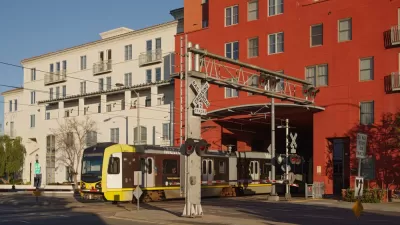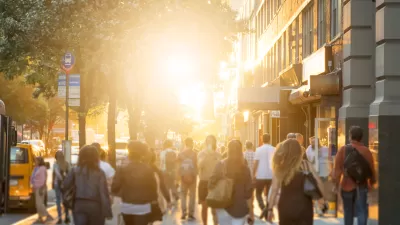Urban Kchoze presents a detailed, step-by-step analysis of the relationship between commercial density and residential density to find a better understanding of which matters more for promoting walkability.

"[W]alkability is usually measured not by how many people reside near you, but by how many services and shops you can access from where you live," according to a post on the blog Urban Khoze. "So to achieve great walkability, it seems that commercial density is very important." Metrics like Walk Score exemplify this claim, but this post takes a look under the hood, so to speak, by examining a model for proof that commercial density is even more important than residential density in achieving the goals of walkability.
The post begins by examining the example set by old American cities, where commercial buildings cover the entire lot and floor-to-area ratio of 150 percent to 250 percent. That density, however, often times clashes with residential densities just a few blocks away, with FAR in the realm of 25 percent to 30 percent. The lesson from these types of arrangements: "So old American cities had very high commercial densities on main street but relatively low densities in residential areas. And we know these small towns were walkable because they were built in an era where cars were still relatively rare, if not even before, when they didn't exist."
Following some of the implications of that example, the post goes on to set up a model with four scenarios of commercial and residential arrangement to reveal more insight into the importance of density in their relationship. The post's exploration of each of these scenarios informs many concepts that are helpful in understanding planning to improve walkability. The conclusion: "achieving commercial density is far more important to re-establishing walkable cities than densifying residential areas."
FULL STORY: Urban Kchoze

Trump Administration Could Effectively End Housing Voucher Program
Federal officials are eyeing major cuts to the Section 8 program that helps millions of low-income households pay rent.

Planetizen Federal Action Tracker
A weekly monitor of how Trump’s orders and actions are impacting planners and planning in America.

Ken Jennings Launches Transit Web Series
The Jeopardy champ wants you to ride public transit.

Washington Legislature Passes Rent Increase Cap
A bill that caps rent increases at 7 percent plus inflation is headed to the governor’s desk.

From Planning to Action: How LA County Is Rethinking Climate Resilience
Chief Sustainability Officer Rita Kampalath outlines the County’s shift from planning to implementation in its climate resilience efforts, emphasizing cross-departmental coordination, updated recovery strategies, and the need for flexible funding.

New Mexico Aging Department Commits to Helping Seniors Age ‘In Place’ and ‘Autonomously’ in New Draft Plan
As New Mexico’s population of seniors continues to grow, the state’s aging department is proposing expanded initiatives to help seniors maintain their autonomy while also supporting family caregivers.
Urban Design for Planners 1: Software Tools
This six-course series explores essential urban design concepts using open source software and equips planners with the tools they need to participate fully in the urban design process.
Planning for Universal Design
Learn the tools for implementing Universal Design in planning regulations.
Heyer Gruel & Associates PA
Ada County Highway District
Institute for Housing and Urban Development Studies (IHS)
City of Grandview
Harvard GSD Executive Education
Toledo-Lucas County Plan Commissions
Salt Lake City
NYU Wagner Graduate School of Public Service





























